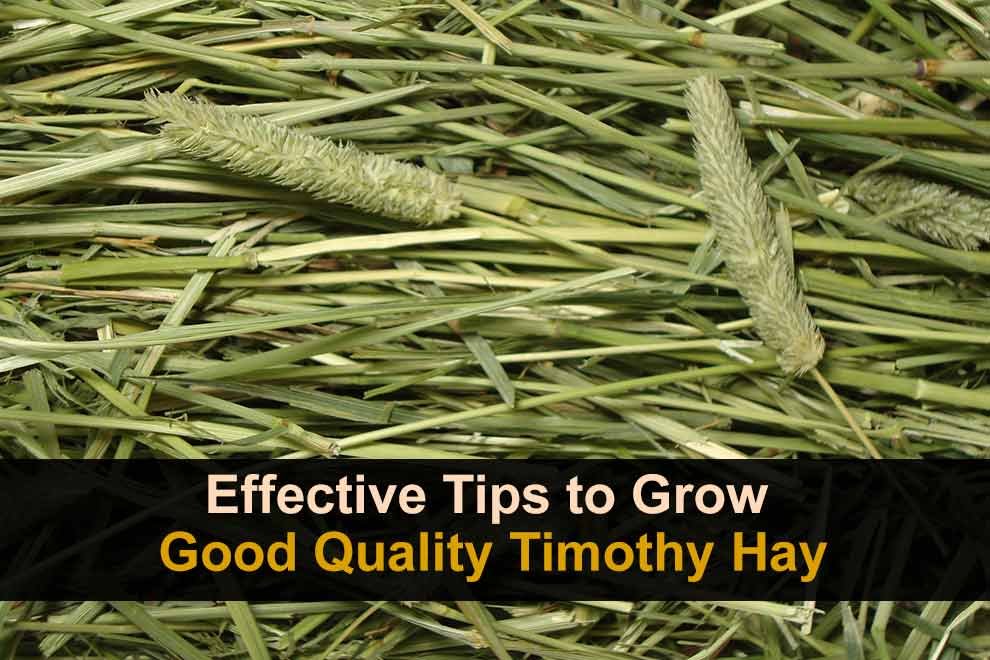Timothy grass, a cool-season forage crop native to Europe and now cultivated globally, is key for domestic animal feed. High-quality hay production hinges on ensuring soil fertility, meticulous land preparation, and precise cutting techniques. Emphasizing these aspects helps farmers worldwide achieve superior Timothy hay yields.
Fertilizer Requirements:
Applying fertilizers based on frequent soil tests is important to grow quality Timothy grass. These tests help determine nutrient levels and ensure proper soil fertility for optimal forage growth.
Nitrogen (N):
Timothy grass responds well to nitrogen. Typically, only 10 to 30 percent of the needed nitrogen for optimal yields comes from soil organic matter. The rest should be added through fertilization.
Apply nitrogen fertilizer in early spring when the grass is growing actively. The specific fertilizer requirements depend on the soil, but a common range is around 40-60 pounds per acre.
Phosphorus (P) and Potassium (K):
Bulk Timothy hay needs adequate potassium and phosphate for healthy growth, standability, and winter survival. Apply about 10 pounds of phosphate per ton and follow soil test recommendations for potassium, ranging from 60 to 260 lbs K2O per acre.
These nutrients contribute to strong root development and disease resistance.
Sulfur:
In the UK, dryland sulfur deficiency reduces the timothy yields. Insufficient sulfur can mimic low nitrogen levels and lead to poor growth. Applying approximately 30 lb/ac with every 12 inches (300 mm) of irrigation water meets Timothy’s sulfur requirements.
However, sulfur distribution in the field may vary in different areas, so conducting a test before applying is always suggested.
Micronutrients:
Check for deficiencies in other essential micronutrients for hay growth, such as iron, zinc, and copper. Address any deficiencies with appropriate fertilizers.
Good Growing Techniques:
Timothy grass, ideal for spring or summer sowing, offers multiple harvests per season when planted early in spring. For successful hay production, employing effective growing techniques and maximizing yield and quality throughout the growing season are essential.
Site Selection:
Select a cooler, northern climate for successful Timothy grass growth to avoid prolonged heat and drought. Choose a site with well-drained, fertile soil rich in organic matter.
The ideal soil pH is between 5.5 and 7.0 but aim for around 6.2 or slightly higher. Test and adjust the soil pH before planting timothy hay to ensure suitable growing conditions.
Seedbed Preparation:
Prepare a good seedbed by tilling the soil and clearing all the debris. Level the ground for even seed distribution. Amend the soil as needed and maintain consistent moisture a few weeks before sowing.
Doing this at least 6 months before the planned planting date is recommended to allow amendments to interact with the soil effectively.
Seeding:
Timothy is often planted in mixtures with legumes or winter grains. It is seeded with the grain in the fall, while the legume is planted early the next spring. Plant timothy seeds at a depth of 0.3 to 1.3 cm (0.125 to 0.5 in).
Follow the seeding rates, which range from 3 to 6 pounds per acre when planted alone and 1 to 3 pounds per acre in mixtures. Broadcast the seeds evenly and lightly rake to cover them. Press or roll the soil to provide good seed-to-soil contact.
Watering:
Keep the soil consistently moist during germination. Once established, Timothy grass needs moderate water but may require irrigation during dry periods. It is well-adapted to areas having effective annual precipitation of at least 45 cm (18 in).
Weed Control:
Optimize hay production by focusing on effective weed control. Start with meticulous seedbed preparation and apply pre-emergence herbicides to prevent weed growth. Incorporate regular mowing to suppress weeds and promote robust, high-yield timothy grass.
Cutting and Storing Process for Timothy Hay:
Timothy grass is best grazed when it reaches 15 cm (6 in) in height during the vegetative stage. Hay production’s ideal harvest time is just before bloom, usually after at least 50 days of growth. Harvest early to make sure high-quality forage with optimal nutrient content.
Well-cured Timothy from top manufacturers like Maple Gems typically produces multiple harvests per season. Allow the grass to regrow 8-10 inches before the next cut. Avoid cutting too close to the ground and maintain 2-4 inches for healthy regrowth.
Dry the grass in the field for a few days before bailing to reduce the risk of mold. Use conditioning equipment to promote faster drying, especially in humid conditions. Store baled hay in a dry, well-ventilated area to prevent spoilage.
Conclusion:
Farmers should prioritize advanced soil nutrient management to ensure high-quality timothy grass cultivation, incorporating organic fertilization and pH balancing techniques. Regular care, including pest control, irrigation optimization, and adopting precise harvesting techniques, ensures nutrient-rich fodder for livestock and sustainable hay production, securing long-term agricultural success.










